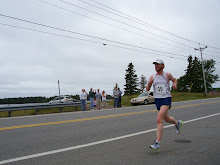May Reading Update
If the May running didn't go so well, at least the reading kept pace:
1. Run Strong edited by Kevin Beck. It deserves a greater review than I'll give it here but suffice it to say it is a good book. It is laid out in sections that cover the different areas of running with the common thread of strength throughout. There are lots of good tips and ideas as well as explanations. One complaint, as I previously mentioned, was it gave me an overtraining injury merely by a discussion in the first chapter. (Right? I mean there wasn't any other explanation that I know of...)
Recommended - but given this audience I'm probably the last to discover it.
2. It takes all kinds by Louis Bromfield. A collection of shorter stories that are not connected. Not my preference (I'm not a short story fan) but enjoyable anyway. The first story, McLeod's Folly, was particularly suspenseful and a pleasure to read. The rest of the book was good but didn't live up to the expectation created by the first selection. I have found two more Bromfields for me to read so you'll see these posted next month.
3. Time Bandit by Johnathan and Andy Hillstrand with Malcom MacPherson. I got this book free of charge from the publisher through the Early Reviewers group at Librarything.com. It is supposedly written in the first person by the co-captains of an Alaskan crab fishing vessel named F/V Time Bandit. The F/V Time Bandit was made famous by the Discovery Channel's show Deadliest Catch. The whole book is a collection of disjointed sea stories peppered with vulgar language and low class living. The thinnest thread of an impending disaster runs from the first chapter to the last. And I mean thin. The subject of the book (Alaskan crab fishing and its dangers) could have been much better told by a real novelist or narrator (fiction or non). What they were thinking here is beyond me.
4. The Two Cultures and A Second Look by C.P. Snow. An essay on the lack of communication between the literary community and the scientific community in England (and the West) in the 1950's. The second part of the book (A Second Look) is the author's response to published criticism of the essay five years later. Initially the Rede Lecture at Cambridge University in 1959, it was published in book form later that year. After reading Time Bandit, this book was a refreshing splash of crisp argument. Satisfying.
1. Run Strong edited by Kevin Beck. It deserves a greater review than I'll give it here but suffice it to say it is a good book. It is laid out in sections that cover the different areas of running with the common thread of strength throughout. There are lots of good tips and ideas as well as explanations. One complaint, as I previously mentioned, was it gave me an overtraining injury merely by a discussion in the first chapter. (Right? I mean there wasn't any other explanation that I know of...)
Recommended - but given this audience I'm probably the last to discover it.
2. It takes all kinds by Louis Bromfield. A collection of shorter stories that are not connected. Not my preference (I'm not a short story fan) but enjoyable anyway. The first story, McLeod's Folly, was particularly suspenseful and a pleasure to read. The rest of the book was good but didn't live up to the expectation created by the first selection. I have found two more Bromfields for me to read so you'll see these posted next month.
3. Time Bandit by Johnathan and Andy Hillstrand with Malcom MacPherson. I got this book free of charge from the publisher through the Early Reviewers group at Librarything.com. It is supposedly written in the first person by the co-captains of an Alaskan crab fishing vessel named F/V Time Bandit. The F/V Time Bandit was made famous by the Discovery Channel's show Deadliest Catch. The whole book is a collection of disjointed sea stories peppered with vulgar language and low class living. The thinnest thread of an impending disaster runs from the first chapter to the last. And I mean thin. The subject of the book (Alaskan crab fishing and its dangers) could have been much better told by a real novelist or narrator (fiction or non). What they were thinking here is beyond me.
4. The Two Cultures and A Second Look by C.P. Snow. An essay on the lack of communication between the literary community and the scientific community in England (and the West) in the 1950's. The second part of the book (A Second Look) is the author's response to published criticism of the essay five years later. Initially the Rede Lecture at Cambridge University in 1959, it was published in book form later that year. After reading Time Bandit, this book was a refreshing splash of crisp argument. Satisfying.


0 Comments:
Post a Comment
<< Home